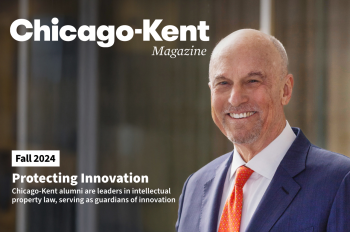IIT Researchers Link Internet Devices to Phone Service
A pair of computer science researchers at Illinois Institute of Technology (IIT), in partnership with Lucent Technologies Inc., have discovered a way for computer networks to talk directly with both wired and wireless telephone networks, opening the door for a wide range of new communications applications.
Professor Xian-He Sun of IIT’s computer science department and Vijay K. Gurbani, an IIT Ph.D. candidate and distinguished member of the technical staff in Lucent’s Wireless Networks Group, have spent two years developing this new protocol software, that breaks down historic barriers between voice and data services.
“We’ve developed a software platform that provides popular Internet services like Instant Messaging and Buddy Lists for telephone lines,” said Sun. “While some cellular phone systems have this technology in place, our platform takes it one step further, so it works on your conventional home phone as well. No one has done that before.”
The so-called electronic or E-generation is mainly built on two networks, the computer network or Internet and the public switched telephone network, or PSTN. The phone network has been used for its voice capabilities and the Internet for its data capabilities. While we use them all the time, the two networks have virtually never talked with each other, until now.
“In the few cases that both networks have interacted, the phone network has been primarily used to provide Internet connectivity through modem connections or to digitize voice,” said Gurbani. “What’s been missing is the notion of providing a rich set of services beyond merely digitizing and transporting voice. Our discovery creates the critical bridge that allows this to happen.”
The new IIT-developed software platform provides services that leverage the best of both networks. In the same way computer users can monitor the presence of their “buddies” when they log onto the Internet, now a wired or wireless phone line, when activated, can create a similar entry onto a Buddy List.
"The discovery works both ways,” said Sun. "For example, the telephone network can send an Instant Message to an Internet user notifying him of missed calls. Alternatively, the telephone network can send a message to the software platform, causing it to set up a telephone conference call between many participants.”
“This technology will be extremely helpful to an executive in a meeting who can’t answer his or her phone right away, but would still like to know who is calling,” said Gurbani. “Think of the convenience of receiving an unobtrusive urgent message notification on your Internet-connected laptop, allowing you to respond on your timetable. It creates even more communication freedom for busy people on the go.”
This new software protocol has broader implications than providing Internet-style services to telephone users. As new technologies emerge, including next generation 3G networks and pervasive computing, the protocol will provide a crucial link from the conventional PSTN system to these new communications infrastructures.
Other applications include real-time monitoring. For example, when an individual’s telephone is active, either by dialing or receiving a call, it will cause the telephone network to transmit an instant message to a computer or personal digital assistant (PDA) to report the event. The real-time nature of sending these selected, presence-related events transmitted via Internet also holds the potential to aid law enforcement agencies better track criminal suspects.
There are potential adverse implications of this technology, including privacy issues. Convergence of the two networks could lead to the potential abuse of presence information. For example, safeguards would need to be in place to keep unscrupulous telemarketers from targeting phone users, who the telemarketers know are at home, based on their presence status.
Currently, Sun, Gurbani and other members of their research group have applied for a patent with the U.S. Patent Office. They are also working on further enhancements of their software platform to provide Internet services related to location and mobility of cellular phones.
Founded in 1890, IIT is a Ph.D.-granting technological university awarding degrees in the sciences, mathematics and engineering, as well as architecture, psychology, design, business and law. IIT’s interprofessional, technology-focused curriculum prepares the university’s 6,200 students for leadership roles in an increasingly complex and culturally diverse global workplace.




